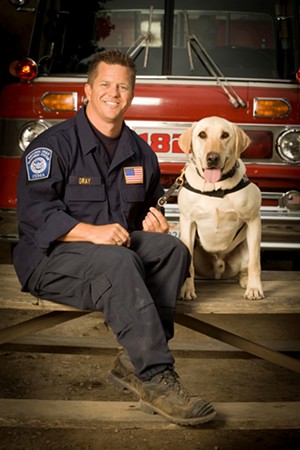Riley paws maniacally at his kennel door, his cute puppy-dog whine occasionally exploding into a deep baritone bark.

“Hey. Hey. I know, buddy,” Santa Barbara County firefighter Eric Gray admonishes the 5-year-old Labrador retriever in a calm, reassuring voice.
“The center of his world is this toy,” Gray says as he holds up what looks like a miniature bowling pin wrapped in fuzzy green tennis-ball felt. “I go through them quite a bit.”
Gray opens the kennel door and a big yellow blur leaps onto the asphalt. After waiting several minutes for Riley to compose himself, Gray uses voice commands and hand signals to send the excited canine hopping back and forth between a tractor tire and a wooden box. Riley scrambles from point to point, his pink tongue flopping.
When the exercise is done, the dutiful pooch finally gets his reward: Gray hurls the toy high into the air. It lands on a dirt hillside several yards away and is quickly enveloped by a four-legged, tail-wagging cloud of dust.
“To him, it’s just a game,” Gray says of the training session.

The organization trains the dogs and their human teammates free of cost to the respective public safety departments.
“We keep everything fun for the dogs so they’re excited to do it,” Executive Director Debra Tosch said. “The people we bury [during rescue drills] are the ones who play tug with them when they’ve been found.”
The dogs are trained to sniff out living humans who are hidden from view.
“We all have a scent that says we’re a living human being, and we all have individual scents, which is the scent that tracking dogs look for. We need [search and rescue] dogs to find everyone,” Tosch said.
Wilma Melville, a retired schoolteacher from New Jersey, founded the Search Dog Foundation in 1996 after volunteering with her own dog at the Oklahoma City bombing site.
At that time, there were only 15 certified search-and-rescue teams in the country. Today, the foundation has trained more than 230, including Santa Barbara County’s Riley and firefighter Eric Gray.
For more information, visit searchdogfoundation.org.
But exercises like these are actually a matter of life and death.
Riley is Santa Barbara County Fire Department’s only urban search-and-rescue dog—a position he’ll continue to hold for at least three more years, since Gray and he recently passed their mandatory evaluation by the Federal Emergency Management Agency (FEMA).
“He did such a good job. I was so proud of him,” Gray says of the recent tests at the Los Angeles County Fire Department’s regional training facility, where FEMA officials simulated a disaster scenario by burying people in a huge pile of rubble.
Riley and Gray located all three individuals during their evaluation, despite poor weather conditions.
“There was no wind and it was 39 degrees outside,” Gray says, noting that the stillness and cool made performing well difficult because “dogs are scent driven and scents are carried on the wind and rise with heat.”
Dogs like Riley are extremely valuable to emergency responders because their keen senses of smell and expert training allow them to locate people trapped in dangerous areas that aren’t accessible to humans.
“He’s a specialized tool,” Gray explains. “Some people have trouble understanding that; I certainly did when I first started doing this. But he’s well cared for. He’s in far better shape than I am. The moment he gets a sniffle, I take him to the vet.”
Because live-scent search dogs are in such high demand, Riley and Gray are also members of regional and state task forces that deploy to disaster zones all over the world.
Since joining the fire department 3 1/2 years ago, Riley has responded to two disasters. Gray and he looked for survivors of Japan’s Tōhoku tsunami in 2011, and searched in 2010 for a Santa Barbara family whose home was demolished by a speeding gravel truck. In both cases, they found no survivors.
“[Riley] is an asset that you never want to use because if I take him out, something terrible has happened,” Gray explains. “He’s an insurance claim that you never want to have to cash in.”
The primary goal of search-and-rescue teams like Riley and Gray is to find survivors, but they also help emergency responders make confident decisions in the field and, in worst case scenarios, they at least give families the closure they need to heal.
“Working [in search and rescue] is never easy, and it’s by no means fun, but that’s what we signed up for from day one,” Gray says.
Contact Managing Editor Amy Asman at [email protected].










